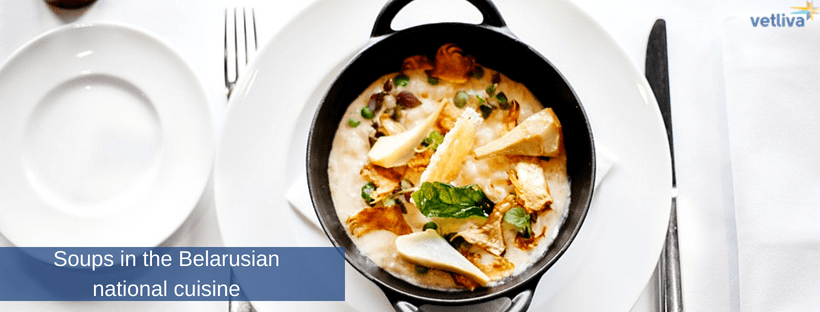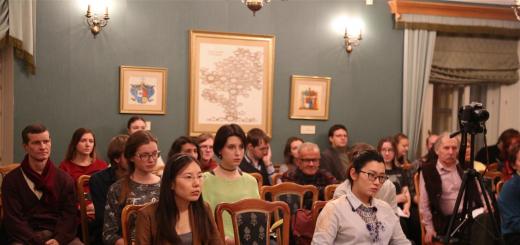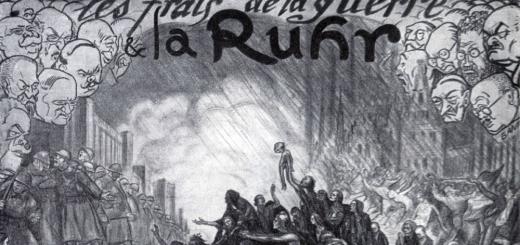Modern Belarusian cookery is based on old national traditions which have undergone a long historical evolution. But the main methods of traditional Belarusian cuisine are carefully kept by the people.
Common in Belarusian cuisine were dishes from potato which is called among people "the second bread". The Belarusians bring fame to their beloved potato in their verses, songs, dances. There are special potato cafes in the country where you can try various potato dishes. Potato is included into many salads, it is served together with mushrooms, meat; different pirazhki (patties) and baked puddings are made from it. The most popular among the Belarusians are traditional draniki, thick pancakes, prepared from shredded potatoes. A wide spread of potato dishes in Belarusian cuisine can be explained by natural climatic conditions of Belarus which are propitious for growing highly starched and tasty sorts of potatoes.
A lot of place in the diet of the Belarusians belongs to meat and meat products, especially to the pork and salted pork fat. One of the people"s proverbs says: "There is no fish more tasty than tench, as well as there is no meat better than pork". The salted pork fat is used slightly smoked and seasoned with onions and garlic. Pyachysta is one of the traditional holiday dishes. This is boiled, stewed or roasted sucking pig, fowl or large chunks of pork or beef. Dishes prepared from meat are usually served together with potatoes or vegetables such as carrot, cabbage, black radish, peas, etc. It is characteristic that many vegetable and meat dishes are prepared in special stoneware pots.
Among dishes from fish the Belarusians prefer yushka, galki and also baked or boiled river-fish without special seasonings. In general, what concerns the most common seasonings such as onions, garlic, parsley, dill, caraway seeds, pepper, they are used very moderately in Belarusian cookery.
The choice Belarusian food are fresh, dried, salted and pickled mushrooms, and also berries such as bilberry, wild strawberries, red whortlberry, raspberries, cranberry and some others.
Of flour dishes the most popular is zacirka. Pieces of specially prepared dough are boiled in water and then poured over with milk or garnished with salted pork fat.
The Belarusians prefer to use whole milk which affected some methods of making yoghurt and the so called klinkovy cottage cheese. In Belarusian cuisine the milk is widely used for mixing in vegetable and flour dishes.
Myadukha, berezavik, kvas, beer are traditional Belarusian drinks.
Recipes introduced in this book do not expose all the dishes of national cuisine. The methods of cooking of the most popular dishes of old and modern cuisines of the Belarusians are presented here. All the recipes are intended for four helpings; the quantity of products is given in volume and in mass.
We hope that this book will be helpful to all those who are interested in national Belarusian cuisine
Belarusian national cuisine has evolved over the centuries. Belarusian culinary traditions represent a mix of simple recipes used by commoners and a sophisticated cuisine of the nobility, an extensive use of local ingredients and unusual way of cooking.
Old Belarusian recipes have preserved till nowadays, and interest in them amoung county’s visitors is increasing .
In restaurants with national colours you can taste not only Belarusian traditional cuisine but also exquisite dishes that were served up in residences of Belarusian magnates.
The local cuisine can be tasted in farmsteads where the cooking is often unique, common only in particular area with using only fresh farm products.
Here bread is baked according to old recipes and technologies, they cook homemade meat delicacies, cheese from cow or goat"s milk, and sweets from honey, apples and cranberries.
Today many traditional dishes are also popular in home cooking of Belarusians.
The most popular are pork stew (machanka) and vereshchaka, homemade sausages, draniki (thick potato pancakes), kolduny, kletski (dumplings), babka (baked grated potato pie), cold sorrel soup, mushroom soup...

Old Belarusian Cuisine
Belarusian cuisine was formed under the influence of two main factors:
- active farming and extensive use of local produce;
- influences of neighboring countries and migrant settlers
Therefore, Belarusian cuisine is one of the most diverse on the continent. It is similar to the Russian, Lithuanian, Ukrainian, Polish, Jewish, but it is unique in its own way, hearty and delicious.
In the old days, each social class had its own gastronomic traditions so that Belarusian cuisine was divided into cuisine directions: peasant and bourgeois, shlyakhta and high nobility cuisines.
In Belarusian cuisine local products are widely used:
- vegetables and greens (cabbages, turnips, beets, carrots, parsnips, pumpkins, potatoes, cucumbers, onions and garlic, sorrel, nettle, quinoa, orpine roots)
- pulses (beans, peas, lentils, kidney beans)
- grains (rye, barley, oats, buckwheat)
- mushrooms (pickled, dried, powdered)
- fruit and berries (apples, pears, plums, cherries, currants, bilberries, blueberries, cranberries, raspberries, mountain ash, viburnum, rosehip)
- spices and dressings (caraway, coriander, linseed, horseradish, calamus, mustard, juniper, cherry and oak leaves)
Among them there are famous draniki, kolduny, pyzy, potato sausage, kletski, babka…
For centuries Belarusians consumed limited amounts of meat, as a rule, in special meals in the form of salted and sun-dried products. With time, the meat diet expanded. The most common forms of meat were:
- mutton
- poultry (chicken, duck, goose, turkey)
- game (elk, roe, boar, beaver)
Belarusian cuisine is also rich in fish dishes. As a rule, it is river fish (tench, sturgeon, pike, eelpout, bream, eel, trout, perch, carp). Belarusians cooked with fish yushka, dumplings,also they made salt and smoked fish. Today restaurants serve famous "Pike Perch a la Radziwill."
The most common dairy products were curd cheese (made of cow and goat milk), sour cream, and butter. Milk is a regular ingredient of many Belarusian recipes, including all kinds of soups, porridges, mokanka.
Dishes of Belarusian villagers were always hearty, relatively simple in cooking (many dishes were prepared in the oven over low heat for a long time), but always fresh: chilled or warmed food was not served!
Nobility cuisine was more exquisite, with a big variety of products and spices, including exotic ones, and, of course, with the use of more sophisticated cooking technologies. The nobles had an opportunity to indulge themselves in such dishes as aselk lips in sugared vinegar, stuffed eel, rooster broth...
Peculiarities of Belarusian cuisine
There are special features that distinguish Belarusian cuisine from culinary traditions of many other countries, give it a local color and charm.
For example, the Belarusian cuisine is characterized by quite complicated and lengthy processing of products. It includes such methods as braising, stewing, baking, cooking, blanching and roasting, with alternation of several methods in a single recipe.
In many national dishes various kinds of flour are used - flour of oats, buckwheat, peas, rye and its mixtures.
What is more, flour is not only the main ingredient of some dishes (for example, flat cakes called perepecha, special Belarusian pancakes from various kinds of flour, thick pancakes made of peas) but also it is an additive for thickening ("zakolota" for soups). From old centuries in Belarus dough was mixed without adding yeast.
Belarusian cuisine offers a great variety of dishes with vegetables. Many of them are unique in spite of the Slavonic basis.
For instance, there are soup zhur (lean,milk or meat soup) based on oat water, polivka (thin soup with cereals and vegetables),morkva (carrot soup), gryzhanka (rutabaga soup), garbuzok (pumpkin soup) and other kinds of dishes.
A special pride of the national cuisine is traditional Belarusian bread baked from rye flour, without yeast but with a specially grown leaven. It is a very good product for healthy diet .
Belarusian bread is heavy with a pleasant little sour. In old recipes they used different dressings like caraway seeds, linseeds and sunflower seeds. Sometimes bread was baked on a ‘pillow’ of birch and oak leaves.

Belarusian cuisine today
Modern Belarusian cuisine is eclectic. It has saved and revived the old national recipes, dishes from different countries of the world become popular, too.
Today restaurants offer modern versions of traditional Belarusian dishes which reflect original ideas of chefs and principles of gourmet cuisine taking into account diversity of products and seasonal changes. You will definitely appreciate such delicious dishes as:
- Marinated white mushrooms with vegetable oil, hot potatoes, pieces of toasted wheat bread and leek
- Zhur with eggs, smoked meat and sour cream
- Cutlets from buckwheat and chopped meat (grechaniki) with sour cream and leek sauce
- Draniki with apple and sour-cream sauce
- Meat sauce (vereshchaka) with buckwheat pancakes
- Bigos (a dish with sour cabbage) with smoked meat, mushrooms and prunes
- Pyachisto (large pieces of gammon)
- Pear roasted in honey with spices (a recipe of the Radziwill family)
The main changes of Belarusian cuisine during the 20th century were:
- wheat flour and dishes from it became very popular (for centuries Belarusians used mainly rye flour)
- appearing of salads
But if you are in Belarus, you must taste the national cuisine, dishes that only here can be truly Belarusian.
You will discover how delicious, interesting, and sometimes even exclusive and unpredictable Belarusian cuisine is!

Belarusian desserts
For many centuries honey was the main dessert for Belarusians. Solodukha (malt dough), kulaga (thick beverage made from berries, flour, sugar, and honey), and baked apples also were popular. Among famous recipes there are sweet pancakes with cottage cheese and pears a la Radziwill.
Today the most popular desserts are:
- ice-cream, whipped cream
- cakes
- fruits and berries (apples, pears, bilberry, cranberry, strawberry)
Vodka in Belarus
Vodka (Harelka) is the most popular strong alcoholic beverage in Belarus. It appeared in the late 15th century and gradually became one of the most common types of alcohol. Belarusians drink vodka on holidays and special occasions.
Сочинение на английском языке Белорусская еда/ Belarusian Food с переводом на русский язык
На английском языке. Belarusian Food
Belarusian cuisine is considered to be one of the most diverse cuisines in Europe. It has been largely influenced by Baltic, Slavic and even partially German cuisines. Traditional dishes of this country mainly consist of vegetables, meats and breads. Today, visitors of Belarus can try peasant cuisine of the countryside as well as the sophisticated dishes for the nobility. A traditional peasant meal has included a soup and a main course. One of the most delicious Belarusian soups is called “khaladnik”. It’s a cold type of borscht, which is mainly eaten in summer. This beetroot soup is eaten with sour cream. Potato is the main ingredient of many dishes. It is known as the second bread of Belarusians. Perhaps, everyone has heard of “draniki”. These are thick pancakes made of shredded potatoes. Meat is also widely used in Belarusian cuisine, especially pork. One of the traditional holiday dishes is called “pyachysta”. It is a delicious stew made of large chunks of pork or beef. Slightly smoked salty pork with onions and garlic is also popular. Most meat dishes in this country are served with potatoes or other vegetables. Historically, Belarus has little access to any type of seafood however there are some special fish-based dishes. For example, “yushka” - a fish soup boiled without any seasonings. In general, seasonings are not very popular in Belarusian cuisine. The most famous hard drink in Belarus is “harelka”. It’s similar to Russian vodka, but can be flavored with birch sap or forest herbs. Other traditional Belarusian drinks include kvass, beer, myadukha, etc. Traditional desserts, that are famous far beyond the country, are sweet pancakes with cottage cheese.
Перевод на русский язык. Белорусская еда
Белорусская кухня считается одной из самых разнообразных кухонь в Европе. На нее в значительной степени повлияли балтийские, славянские и даже частично немецкие кухни. Традиционные блюда этой страны в основном состоят из овощей, мяса и хлеба. Сегодня посетители Беларуси могут попробовать как крестьянскую кухню сельской местности, так и изысканные блюда для дворянства. Традиционная крестьянская еда включала суп и основное блюдо. Один из самых вкусных белорусских супов называется «холодник». Это холодная разновидность борща, которую в основном едят летом. Этот свекольный суп едят со сметаной. Картофель является основным ингредиентом многих блюд. Он известен как второй хлеб белорусов. Возможно, каждый слышал о «драниках». Это оладьи из измельченного картофеля. Мясо также широко используется в белорусской кухне, особенно свинина. Одно из традиционных праздничных блюд называется «пячысты». Это аппетитное тушеное мясо, приготовленное из больших кусков свинины или говядины. Слегка копченая соленая свинина с луком и чесноком также популярна. Большинство мясных блюд в этой стране подаются с картофелем или другими овощами. Исторически сложилось так, что Беларусь имеет ограниченный доступ к любым морепродуктам, однако есть и специальные рыбные блюда. Например, «юшка» - уха, которую готовят без каких-либо приправ. В целом, приправы не очень приветствуются в белорусской кухне. Самый известный крепкий напиток в Беларуси - это «горилка». Она похожа на русскую водку, но может быть приправлена березовым соком или лесными травами. К другим традиционным белорусским напиткам относятся квас, пиво, мядуха и т.д. Традиционный десерт, который известен далеко за пределами страны, это сладкие блинчики с творогом.
Belarusian national cuisine has existed for many centuries. It’s influenced by , geographical location, and climate. Agriculture causes using a lot of vegetables in cooking national dishes. Mostly, it was local food that was used in Belarusian cookery but there is a little influence fr om migrants fr om the bordering territories.
History of Belarusian cuisine
Recipes of other nations (Baltic, Jewish, German) appeared in Belarusian cuisine since existing of the Grand Duchy of Lithuania. For many centuries Belarusians didn’t consume a lot of meat but they ate lard as the Ukrainians did. It was pickled with its skin. As a substitute for meat there were mushrooms however at that time they were not pickled but dried.

Diary and sweet were almost not consumed in Belarusian cuisine. But there were sweet drinks such as kissel or shortening for a dessert.
Later on Belarusians used more meat in their ration. Usually meat dishes were cooked on holidays. The most popular kinds were pork, beef, poultry and game. Since that time there have been such dishes as machanka, verashchaka, smajanka, home sausages and pickled lard.

River fish was also widely used in national recipes. The most popular species were pike, sturgeon, blackhead, carp, perch, and zander. Soup and dumplings were prepared fr om fish.
Country cuisine was nutritious, simple and fresh. A lot of dishes were served to table being hot. Dishes for princes and gentry were more various and exotic. There were stuffed sanders and delicacy on magnates’ tables.
In Soviet Union times Belarusian cuisine was influenced by other nations. Ukrainian and Caucasian food was served in public places.
In the 20 th century a lot of Belarusian dishes were fr om wheat flour but not from rye as it was earlier. There were also a lot of salads.

Modern Belarusian cuisine
Nowadays it’s hard to use the same products as our ancestors did. Some vegetables and beans disappeared from our table. But many dishes have existed so far: pancakes, dumplings, pickles, kvass and beet soups, home sausages, lard, meat dishes.
Potato is an ingredient that exists in many Belarusian dishes. An average Belarusian eats a half of a kilo of potato every day. There are a lot of potato recipes such as draniki, baked puddings, babka, fried and stewed potato.
In Belarus meat is eaten twice as less than in Poland. By the way the most popular meat is not very useful but tasty pork.

The most popular meat dishes:
- bigos – stewed cabbage with meat;
- kolduny – potato fritters with meat;
- machanka – a sauce from different sorts of meat, served with pancakes;
- smajanka – meat pie.

As for alcohol drinks there are nastoykas from vodka, cranberry, honey such as zubrovka, crambambulya. Kvass and birch sap is also popular.
Deserts
Honey has been popular throughout all the history. Belarussians like pancakes with honey, honey cereals and pies. Soloduha (a sort of pastry), kissel, baked apples were cooked with honey.
Praniki is a sweet flour dish that was originally called “perniki”. People believe that it took its name from pagan times when people worshipped many gods and one of them was Perun, god of the Sun. At that time people brought something to Gods and especially figures of animals from sweet and tasty pastry. Later on the name changed as well as its taste because now they are made from wheat flour but not from rye.

Pancakes
Scientists still argue about the appearance of pancakes. There are several ideas. Some suggest that pancakes were baked from rye kissel. Another believe that the word ‘pancake’ appeared from the word “mlin” (mill). Earlier pancakes were baked from different sorts of flour. Now they are made mostly from wheat flour, yeast, milk, sour cream, kefir. Usually pancakes are eaten with various toppings, jam or honey.

Belarusian restaurants
You can taste national recipes at wh ere you can find a lot foreign guests who came to our country. There you can taste not only country dishes but also meals from princes’ tables.
There are a lot of and wh ere you can taste fresh baked bread, meat sausages, home cheeses, desserts from honey and fruits.
In a menu of Belorusian restaurants one can find not only our national cuisine but European, Caucasian and oriental dishes. Dishes cooked according to old recipes can be tasted during an , which you can book directly on our website.
However tourists should taste specific belarusian meals such as draniki, borshch, machnka, sour cabbage, pickled cucumbers, lard and national nastoykas.
All Belarusians like nutritious and tasty food. You can make sure if drop in one of the local restaurants.
Билет № 7. Belarusian Cuisine
Do you like cooking? Why (not)?
What questions will you ask a friend who has invited you to a pot-luck party?
Let’s talk about Belarusian national cuisine (food). What can you tell me about eating habits in Belarus?
Modern Belarusian cookery is based on old national traditions. Dishes from potatoes are very common in Belarusian cuisine. Potatoes are called ”the second bread” in Belarus. Potatoes are included into many salads, served together with mushrooms and meat; different pies and baked puddings are made from it. The most popular among the Belarusians are traditional draniki, thick pancakes, prepared from shredded potatoes. A lot of place in the diet of the Belarusians belongs to meat and meat products, especially to the pork and salted pork fat. The salted pork fat is used slightly smoked and seasoned with onions and garlic. Dishes prepared from meat are usually served together with potatoes or vegetables such as carrot, cabbage, black radish, peas, etc. Belarusian national cuisine also offers fresh, dried, salted and pickled mushrooms and also various berries such as bilberry, strawberries, raspberries, cranberry and some others. An integral part of any dinner is soup. It can be hot or cold. Belarusians are fond of borscht, a thick and rich beet and cabbage soup made with grains, potato and meat. The Belarusian khaladnik , a cold borscht made of beets, beet leaves and served with sour cream, hard-boiled eggs, and boiled potatoes will be pleasant on a hot summer day. Another popular Belarusian dishes are “zatsirka” and “krupnik” (soup made from cereals). Every possible salads are prepared from cabbage, carrots, beans.
Do you like cooking? Why? Why not?
A. Yes, I do. My mother is a very good cook and she taught me to cook pizza, pancakes and roast chicken.
B. In fact, I don’t like cooking. I think it’s boring. My mum does it better. I only help her in the kitchen.
C. No, to tell the truth I don’t like cooking. It takes a lot of time and frankly speaking I am not very good at cooking and my dishes are not always tasty.
What questions can you ask a friend who has invited you to a pot-luck party?
I have never been to a potluck party. It’s probably amazing. Of course I will have to find out some things beforehand:
What is the theme of your potluck party?
How many people have you invited to the party?
Are you going to make a list of dishes?
What dish shall I bring?
Where will the party take place?
Shall I bring some plates or cups?
Shall I bring some drinks?
Who else is invited to the party?
What national dishes can you recommend a tourist to taste in Belarus?
When people come from other countries they usually look for something special and traditional in this country. So I think it would be a good idea to recommend them to eat our draniki. To my mind this dish is a speciality of our country, it is delicious. You can also taste borchs and holodnik.
Can you tell me how to cook one of your favourite dishes?
Frankly speaking I am not very fond of cooking but I can tell you how to prepare draniki. First you should peel some potatoes, then you should grate them, add an egg , some flour, some salt, mix everything and make little pancakes on a frying pan. Serve your draniki hot with sour cream. Bon appetite!










